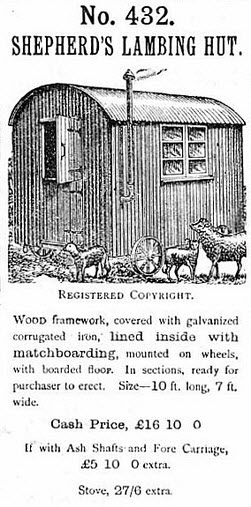The Shepherds Hut And The Changing Face Of The Countryside
A milk stand at the end of each farm track was a feature of the countryside as I grew up in the Eden valley, in the county of Cumbria in the 1970s. Each day the farmer would place his daily milk production into the 10 gallon aluminium milk churns and place them on the milk stand by the side of the road. Soon after, to a precise schedule, a lorry would pull up next to the milk stand and exchange the full milk churns for empties for filling the next day. The lorries would then take the milk to the regional dairy for processing.
 Shepherds hut by Boulton and Paul
Shepherds hut by Boulton and Paul
This method of collecting milk and transporting it to regional dairies was in common use in the early 1970s but by the end of the decade the milk stands were standing derelict. The stone milk stands remained but the wooden ones fell into disrepair and finally disappeared.
Change is a feature of the countryside and it affected shepherds huts too.
Shepherds huts had their heyday over a period of about 100 years
There were two reasons for the development of the shepherds wheeled hut;
The first, and most expected, is the requirement that the shepherd be near his flock during the lambing season of February and March to look after the sheep as they give birth to the young lambs. This is the busiest and most intensive time of the shepherds year and having a place to sleep and eat near the flock was essential.
The second reason was the traditional way that many of the lowland sheep farms used sheep to improve the land. In the upland areas of Cumbria where I come from the land was either too steep or too boggy for these wheeled huts to have widespread use. But in the Cotwolds and the Downs of Southern England the land was more gently sloping. However in these areas the upland ground was often poor and stony.
To improve the land for the growing of cereal crops, sheep were gathered into fields in concentrated areas called folds. The sheep ate the grass or other forage crop leaving behind them fertiliser (sheep poo) that helped to improve the fertility of the stony ground and it was then ploughed and oats, barley or wheat were planted.
As the flock moved on the hut could be pulled along to a new location to keep up with the sheep. First mention of wheeled shepherds huts can be found in the early 1600s.
The shepherds hut gradually developed into a mass produced item
The pictures show a variety of wheeled huts built by the Victorian company Boulton and Paul. A typical Shepherds hut had windows on all four sides so that the flock could be observed in any direction. The undercarriage was of cast iron, although earlier versions were said to be of timber though few of these survive. The 1894 catalogue shows versions with timber and corrugated iron cladding. The ones that are most often seen today are the ones with the metal cladding and I suspect that these ones were the most durable. As the huts would be quite exposed to the weather in these upland areas.
 One wheeled hut - many uses
One wheeled hut - many uses
Inside the huts would be a bed, a fold down table and a small wood burning stove to keep the place warm. There was also space for the shepherd to store any of the tools and equipment that he needed to keep secure.
The hut was a place for the shepherd to get out of the weather, sleep, stay warm and also there would be space under the bed for any orphaned lambs to stay and keep warm too.
Do you remember the milkstands of rural Cumbria?
Their use declined because of the development of the milk tanker. Instead of filling up the milk churns each day the farmer put all the milk that was produced into a large storage tank near the dairy where the milk was taken from the cows. The lorry with a bulk storage tank would pull into the farmyard and suck all of the milk out of the tank. Much more quick, efficient and hygienic.
Similar sorts of change brought about the decline of the shepherds hut
The development of nitrates for explosives in the First World War heralded the widespread use of chemical fertilisers and this meant that the age old method of fertilising the upland areas using the sheep folding method became obsolete. Like the milk stands the shepherds wheeled hut was put to one side and allowed to gradually decay.
Life goes in cycles
Just as technological change hastened the demise of the shepherds hut, so modern technology is driving its resurgence today.
| Share this page: | ||







Would you prefer to share this page with others by linking to it?